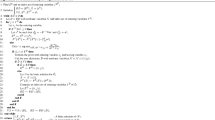Abstract
In this paper, an interactive paired comparison simplex based method formultiple objective linear programming (MOLP) problems is developed and compared to other interactive MOLP methods. The decision maker (DM)’s utility function is assumed to be unknown, but is an additive function of his known linearized objective functions. A test for ‘utility efficiency’ for MOLP problems is developed to reduce the number of efficient extreme points generated and the number of questions posed to the DM. The notion of ‘strength of preference ’ is developed for the assessment of the DM’s unknown utility function where he can express his preference for a pair of extreme points as ‘strong ’, ‘weak ’, or ‘almost indifferent ’. The problem of ‘inconsistency of the DM’ is formalized and its resolution is discussed. An example of the method and detailed computational results comparing it with other interactive MOLP methods are presented. Several performance measures for comparative evaluations of interactive multiple objective programming methods are also discussed.
Similar content being viewed by others
References
L.F.B. Baptistella and A. Ollero, Fuzzy methodologies for interactive multicriteria optimization, IEEE Transactions on Systems, Man, and Cybernetics, Vol. SMC-10, 7(1980)355.
J.S. Dyer and R.K. Sarin, Measurable multiattribute value functions, Oper. Res. 27, 4(1979).
J.G. Ecker and I.A. Kouada, Finding all extreme points for multiple objective linear programs, Math. Progr. 14(1978)249.
G.B. Hazen and T.L. Morin, Optimality conditions in nonconical multiple objective programming, J. of Optimization Theory and Applications 40(1983)25.
Y.Y. Haimes and W.A. Hall, Multiobjectives in water resources systems analysis, the surrogate worth tradeoff method, Water Resources Research 10, 4(1974).
C.L. Hwang and A. Masud,Multiple Objective Decision Making Methods and Applications (Springer-Verlag, 1979).
J.P. Ignizio,Linear Programming in Single and Multiple-Objective Systems Prentice-Hall, Englewood Cliffs).
B. Malakooti, An interactive paired comparison method for multiple criteria decision making and optimization, Ph.D. Diss., School of Industrial Engineering, Purdue University, West Lafayette, Indiana (1982).
B. Malakooti, Assessment through strength of preference, Large Scale Systems: Theory and Applications 8(1985)169.
B. Malakooti, An interactive paired comparison method for MOLP problems with an underlying quasi-concave utility function, Working Paper No. 9-1-85, Systems Engineering Dept., CWRU, Celeveland, Ohio(1985).
B. Malakooti, An interactive paired comparison method for exploring the efficient facets of MOLP problems with an underlying quasi-concave utility function, Working Paper No. 4-3-85, Systems Engineering Dept, CWRU, Cleveland, Ohio (1985).
B. Roy, Partial preference analysis and decision-aid: The fuzzy outranking relation concept, in:Conflicting Objectives in Decisions, ed. D. Bell, R. Kenney and H. Raiffa (Wiley, New York, 1977).
S. Sadagopan and A. Ravindran, Interactive solution of bi-criteria mathematical programs, Nav. Res. Log. Quart. 29, 3(1982).
R.E. Steuer, Multiple objective linear programming with interval criterion weights, Management Science 23, 3(1976)305.
R.E. Steuer, An interactive multiple objective linear programming procedure, in:Multiple Criteria Decision Making, ed. M.K. Starr and M. Zeleny (North-Holland, New York, 1977) p. 225.
R.K.Sarin, Interactive evaluation and bound procedure for selecting multi-attribute alternatives, in:Multiple Criteria Decision Making, ed. M.K. Starr and M. Zeleny (North-Holland, New York, 1977).
V. Srinivasan and A.D. Shocker, Estimating the weights for multiple attributes in a composite criterion using pairwise judgments, Psychometrika 38, 4(1973)337.
P.J.H. Schoemaker and C.C. Waid, An experimental comparison of different approaches to determining weights in additive utility models, Management Science 28, 2(1982)182.
J. Wallenius, Comparative evaluation of some interactive approaches to multicriterion optimization, Management Science 21, 12(1975)1387.
P.L. Yu and M. Zeleny, Linear multiparametric programming by multi-criteria simplex method, Management Science 23, 2(1976)159.
M. Zeleny, A concept of compromise solutions and the method of the displaced ideal, Computers and Operations Research 1, 4(1974)479.
M. Zeleny,Linear Multiobjective Programming (Springer-Verlag, New York, 1974).
S. Zionts and J. Wallenius, Identifying efficient vectors: Some theory and computational results, Oper. Res. 28, 3 (1980) Part II.
S. Zionts and J. Wallenius, An interactive programming method for solving the multiple criteria problem, Management Science 22,6(1976)652.
S. Zionts and J. Wallenius, An interactive multiple objective linear programming method for a class of underlying nonlinear utility functions, Management Science 29, 5(1983).
Author information
Authors and Affiliations
Additional information
All rights reserved. This study, or parts thereof, may not be reproduced in any form without written permission of the authors.
Rights and permissions
About this article
Cite this article
Malakooti, B., Ravindran, A. Experiments with an interactive paired comparison simplex method for molp problems. Ann Oper Res 5, 575–597 (1986). https://doi.org/10.1007/BF02739240
Issue Date:
DOI: https://doi.org/10.1007/BF02739240




